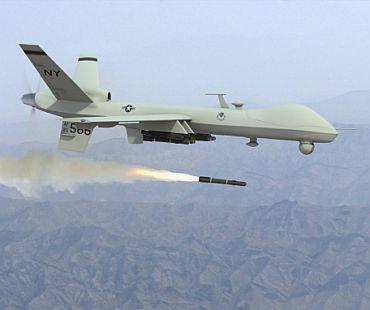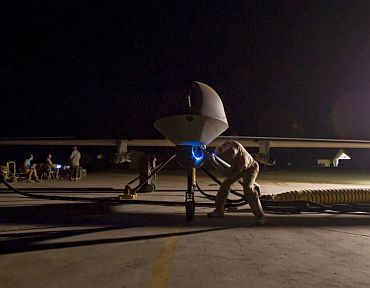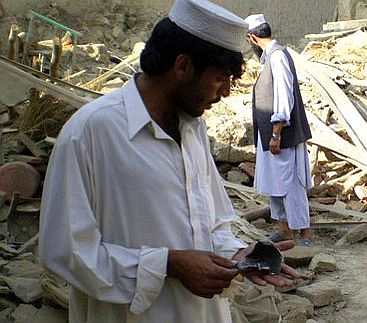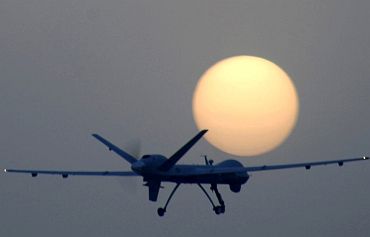Photographs: Reuters
Since September 2, there have been 13 strikes by unmanned spy planes in North Waziristan the highest number in a month since the US began using drones to hit targets in Pakistan in 2004, the Dawn newspaper reported.
The number of drone strikes this year has already crossed 70, the highest figure for a single year.
about the US onslaught...
US gameplan in Pak's northwest
Image: Militants belonging to the Haqqani network at an undisclosed locationThe US is hoping to downgrade the operational capabilities of the Haqqani group, which it considers the most lethal militant outfit in Afghanistan.
Military sources were quoted by the Dawn as saying that an operation in North Waziristan had been delayed because the Pakistan Army is preoccupied with fighting militancy in other tribal areas and flood relief efforts.
This window was fully exploited by the Haqqani group to intensify its activities, defence analysts said.
Few takers in Washington for Pak excuses
Image: A drone undergoes maintainence procedure at a US base in AfghanistanThe daily reported that there were "few takers for the Pakistani explanation" about the delay in launching an operation in North Waziristan and many described the delay as tactical.
Pakistan had in June initiated efforts to secure a place for the Haqqani group in post-war Afghanistan by working out a rapprochement between the network and the Hamid Karzai government.
The US opposition to the initiative halted the move.
Al Qaeda too is on the strike radar
Image: Villagers pick up rocket fragments after a drone strikeSources said Pakistan would make fresh moves to discuss peace with the Haqqanis, in the context of the overall reconciliation plan, during Afghan President Hamid Karzai's current visit to Pakistan.
Karzai arrived in Islamabad on Wednesday on a two-day visit.
The pattern of the drone attacks this month showed that the primary target was the Haqqani network, though its host commander Hafiz Gul Bahadar and foreign militants of Al Qaeda have also been targeted.
The drone strikes, this month, have predominantly been in Miranshah sub-division, where the Haqqani network's headquarters are based and where the group carries out its financial dealings, acquisition of weapons and strategic planning.
US pursuing the hammer and anvil approach
Image: A US drone returns to base after a routine sortieGul Bahadar, who leads the other major militant group in North Waziristan, provides the Haqqanis the tribal support they lack and gives them passage to the border.
The US, while targeting the Haqqanis, is pursuing the "hammer and anvil approach".
Alongside the spike in drone attacks, US Special Forces have launched an intense operation against the group in eastern Afghanistan, killing a number of its commanders.
Why the US feels encouraged to use drone more often
Image: File photo of Pakistani Taliban chief Baitullah MehsudIn this unprecedented intense bombardment by drones, Pakistani military officials see a shift in US policy in Afghanistan from counter-insurgency to counter-terrorism.
They said the US, notwithstanding international denunciation of drone attacks, feels encouraged because the strikes have killed second and third tier leaders of militant groups.
More than 1,200 militants have been killed in over 130 drone strikes since August 2008.
Those killed include Pakistani Taliban chief Baitullah Mehsud, Al Qaeda's no 3 Abu Mustafa al-Yazeed and some other top operatives of the terror group.







article